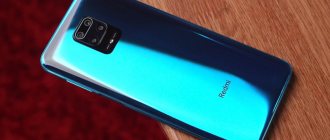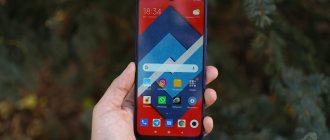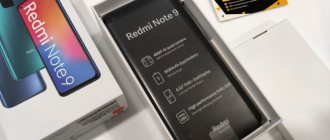At the end of January, Redmi CEO Lu Weibing announced the imminent release of the company's first gaming smartphone. Fans of mobile games and gadgets immediately became interested in the new model, eagerly awaiting its release. And finally, the Redmi K40 Gaming Edition has hit the market.
Redmi K40 Gaming Edition is a new generation of K40 series smartphones; the design of this gaming phone is fundamentally different from its competitors. Large battery and weight, lighting effects, fan - features that we will see in all gaming smartphones. They try their best to say we are different. But, the K40 Gaming Edition is not very similar to its competitors, its appearance is almost ordinary, since most people need a phone with high performance, and only then a device for games.
What else is special about this smartphone? Find out from my review.
Specifications Redmi K40 Gaming Edition
| Screen | 6.67 inches, OLED, 1 billion colors, 2400x1080 pixel resolution, 120 Hz refresh rate, 480 Hz touch sampling rate, HDR10+, 500 nits (typ), 20:9 ratio, ~395 ppi density, Corning Gorilla Glass 5 |
| CPU | MediaTek MT6893 Dimensity 1200 5G (6nm), octa-core (1×3.0 GHz Cortex-A78 + 3×2.6 GHz Cortex-A78 + 4×2.0 GHz Cortex-A55) |
| Graphic arts | Mali-G77 MC9 |
| RAM | 6/8/12 GB LPDDR4X |
| Inner memory | 128/256 GB UFS 3.1, no expansion |
| System and software | Android 11, MIUI 12.5 |
| Main cameras | 64 MP, f/1.7, 26 mm (wide), 1/2.0 inch, 0.7 µm, PDAF + 8 MP, f/2.2, 120˚ (ultrawide) + 2 MP, f/2.4, (macro) Video: 4K at 30 fps, 1080p at 30/60/120 fps, 720p at 960 fps, HDR |
| Front camera | 16-MP |
| Audio | Stereo speakers, 24bit/192kHz, JBL tuned, no 3.5mm |
| Communications and connections | WLAN Wi-Fi 802.11 a/b/g /n/ac/6, dual-band, Wi-Fi Direct, hotspot, Bluetooth 5.2, A2DP, LE, GPS with A-GPS, GLONASS, BDS, GALILEO, QZSS, NavIC, NFC, Infrared port |
| Water resistance | IP53, dust and splash proof |
| Sensors | Fingerprint (side-mounted), accelerometer, gyroscope, proximity, compass, barometer, color gamut |
| Connector | USB Type-C 2.0, USB On-The-Go |
| Battery | 5065 mAh Li-Po, non-removable, fast charging 67 W, 100% in 42 minutes (advertised), Power Delivery 3.0, Quick Charge 3+ |
| Materials | Gorilla Glass 5 protection on front and back |
| Dimensions and weight | 161.9×76.9×8.3 mm, 205 grams |
| Price | From 37,000 rub. |
Design and appearance
When you pick up the Redmi K40 Gaming Edition for the first time, you realize that this is a gaming smartphone. Compared to other competitive models, the device is very thin and light. The thickness of the case is only 8.3 mm, and the weight is 205 grams.
The design of the K40 Gaming Edition is quite modest, the back panel is covered with protective glass. There are two color versions, black and silver, the latter being different shades of silver and grey. There are symmetrical lines on the sides that visually make the body more slender. In the middle you can see the inscription “Fighting”, making it clear that this is a gaming smartphone.
The module with three cameras in the upper left corner is designed in the shape of a closed racing track (oval). Along the edges of the module are the inscriptions Freezing and Speediest. The first talks about the cooling system of the smartphone, the second – high operating speed. To the right of the module there is a flash in the shape of a lightning bolt.
Although the design of the Xiaomi Redmi K40 Gaming Edition is different from most gaming smartphones, it comes with RGB lighting. The LED ring is hidden in the camera module; it is not only used to demonstrate various lighting effects, but also serves as a notification indicator. While charging, it will display the current battery status.
Design
The back cover of Redmi K40 in blue color shimmers beautifully. Photo: Paco Zheng / gizmochina.com
The highlight of the smartphone is its relatively small size, despite the capacious battery. The thickness is 7.8mm and the weight is 196g. This is a huge upgrade over the 2022 Redmi K30 Pro which weighs 218g and is 8.9mm thick.
The front panel of the smartphone is covered with Gorilla Glass 5 protective glass. At the top there is a tiny hole for the selfie camera.
Beneath the thin grille above the screen is one of the two top stereo speaker outputs. There is no notification LED.
There is a two-stage camera module installed in the upper left corner of the rear panel. The first level houses an LED flash and an ambient light sensor. The second has three cameras and a microphone. The company logo is printed on the bottom.
The left side of the smartphone is empty. On the right are the volume rocker and the power button, which has a built-in fingerprint scanner. It is always on, works quickly and accurately.
There are two grilles on the top edge: the first is for one of the top speaker outputs, and the second hides the microphone and IR port. Another stereo speaker, USB-C port, dual SIM tray and main microphone are located at the bottom.
Redmi K40 comes in black, silver and blue colors. The last two change shade depending on the lighting.
The smartphone does not have an official IP rating, but it has a special nano-coating that protects it from splashes.
Smartphone display
One of the most important aspects of gaming smartphones is the screen. Redmi K40 Gaming Edition offers a 6.67-inch OLED display with a resolution of 2400x1080 pixels. The refresh rate is 120 Hz, and the sensor layer polling rate is 480 Hz.
The quality of the K40 Gaming Edition display is no different from the AMOLED in Samsung smartphones. HDR10+ technology is supported, and Corning Gorilla 5 glass is responsible for protection. But, due to the panel from a third-party manufacturer, the front camera hole is slightly larger than that of the K40.
Peak brightness is also lower than the K40, however, the bottom bezel is only 2.7mm wide. Since the side frames are not much smaller - 1.8 mm, they are almost symmetrical, which contributes to a better immersion effect.
Display
The screen is one of the main advantages of the K40. Photo: Paco Zheng / gizmochina.com
The Redmi K40 / POCO F3 features a Samsung-made Super AMOLED flat panel with a diagonal of 6.67 inches, a resolution of 1080 x 2400 pixels and an aspect ratio of 20:9.
There is support for HDR10+ for viewing video content in high resolution and a screen refresh rate of 120 Hz, which has a positive effect on the smoothness of the image. The touch sampling rate is 360Hz, which means the screen is responsive.
The display is very bright (maximum 1304 nits), the content is visible outdoors even on a super sunny day. And the minimum screen brightness is comfortable for reading in the dark.
Thanks to the tiny size of the camera cutout, you will be completely immersed in the video without paying attention to the front camera. Another advantage of the panel is the “Adaptive Color Display” option. It adjusts the screen color temperature according to the ambient light. As a result, eye strain is reduced.
If you do not take into account the rather wide bezels, the screen for a smartphone in this price category is simply excellent!
Trigger keys
A special feature of the Xiaomi Redmi K40 Gaming is the retractable side trigger buttons used in games. They work on the basis of magnets, and move up when you switch a special slider at the bottom.
According to Redmi, the K40 Gaming Edition's retractable keys will withstand about 1.5 million lifts. Unfortunately, these buttons only work in games, and you won’t be able to reassign them to another function, as was the case with the Black Shark 4 smartphones.
On the right side there is a power key with a built-in fingerprint scanner. Although on the regular versions of the K40 line, double-tapping can be assigned to any function, the Redmi K40 Gaming Enhanced Version does not have this option.
Differences between Redmi K40 and POCO F3
POCO F3 is the international version of Redmi K40. However, smartphones have several differences:
| Comparison parameter | POCO F3 | Redmi K40 |
| Frame | Metal frame | Plastic frame |
| Memory configurations: RAM and built-in | 6 GB and 128 GB, 8 GB and 256 GB | 6 GB and 128 GB, 8 GB and 128 GB, 8 GB and 256 GB, 12 GB and 256 GB |
| Colors | Black, white, blue | Black, silver, blue |
| Price, rubles* | from 28,150 for 6 GB and 128 GB versions | not on sale, expected price - from 29,990 for the 8 GB and 128 GB version |
K40 Gaming Edition cameras
Cameras don't get the attention they deserve on gaming phones, but that's not the case here. The Redmi K40 Gaming Edition smartphone has three main cameras: a 64-megapixel main camera, an 8-megapixel ultra-wide-angle lens and a 2-megapixel macro lens.
The main camera uses hybrid optics (1 glass lens + 5 plastic lenses). This provides incredibly fast focusing and higher light transmission.
You'll see every detail when shooting during the day, where the high quality is best seen in the 64MP mode. Even when zoomed in, every object in the frame is clearly visible, and photos from the main sensor are magnificent. When shooting in the dark, Xiaomi Redmi K40 Gaming Edition uses hybrid optics, which allows you to capture more light and improves clarity.
The quality of the ultra-wide-angle camera and macro lens is not outstanding, although it is not bad. There is also a special video mode with background blur.
The main camera collects important information about the scene, and the ultra-wide-angle camera analyzes depth. The result is a more realistic background blur effect.
Of course, the K40 Gaming Edition is not a camera phone, so it’s not ideal for shooting. What's missing here is the telephoto lens, where the resulting colors are quite pale. However, compared to other gaming smartphones, the model performs well.
Software
Although the MIUI12 features are impressive, the optimization of the Xiaomi skin is not the best. Redmi K40 Gaming Edition runs stable MIUI 12.5 based on Android 11.
I'm glad that the user interface has been improved, and loading applications and switching backgrounds has become smoother. According to official statements, MIUI 12.5 has optimized and improved power consumption and improved performance.
This version of the system is naturally the best of MIUI, the smooth and smooth performance provided by various dynamic effects and rendering is by far the best among the current ones in the mobile user interface. But, you won’t be able to flash it or install Google services here, at least not yet.
Redmi K40 review: battery life
The K40 comes with a 4520mAh battery. After our tests, half an hour of Tiktok and half an hour of 1080p internet videos only consume 5% of the power. 30 minutes on Genshin Impact consumes 18%. 20 minutes on BrightRidge consumes 20%. This battery optimization is still good.
Redmi k40 Charging speed
Although the K40 still uses 33W charging, they have optimized it a lot this time. It charges up to 69% in half an hour and can be fully charged in 54 minutes. So it's faster than the 40W charging of many other brands. So you don't need to worry that 33w k40 is not enough.
Redmi k40 battery life
Component Performance
Redmi K40 Gaming Edition is equipped with a MediaTek Dimensity 1200 processor manufactured using a 6nm process technology. The main core has a clock speed of 3.0 GHz.
The Dimensity 1200 scores close to the Snapdragon 870 in benchmark tests. Geekbench 5 scores 793/2946 in single-core and multi-core modes. This is the flagship level among Android smartphones.
What's more important here is high gaming performance, the K40 Gaming Edition boasts Redmi's Game Turbo gaming mode. It helps the smartphone handle games without any problems. In Honor of Kings, the device consistently produces 90 frames per second with maximum graphics settings. The same goes for Peace Elite.
The performance of Redmi K40 Gaming is better than many Snapdragon 870 gadgets.
Redmi K40 review: design
Redmi K40 comes in a standard size box. The charger and cable missing from the Mi 11 box reappear in the K40 box. A 33W charger is included in the package, we'll talk about charging later.
At first glance, you realize that the K40 is much more sophisticated than the K30. It weighs only 196g and is 7.8mm thick. The entire back is a continuation of the design of the Mi 11. The camera module is elongated, the elements are distributed more evenly. This makes the rear end look much better than its predecessor.
The red and blue gradient color is the main color of the K40. It refracts blue and red in different light. While this isn't the first time we've seen this color, if you're someone who likes a design that stands out, you'll definitely love this one.
Redmi K40
The side-mounted fingerprint sensor integrated into the power button is slightly raised. This sets the phone apart from previous fingerprint-enabled phones, which had the sensor located in a notch on the side.
The advantage is that it is more integrated into the frame and looks like a regular power button. And this makes it easier to press with your finger. Overall, the K40's design is definitely an improvement. It's even better than the Mi 11. This should be the first time Redmi is on par with Xiaomi in terms of design.
Buy Redmi K40 on AliExpress
Redmi K40Cooling system
Xiaomi Redmi K40 Gaming Edition also has a three-level cooling system that does a good job of dissipating heat. The main components are covered with large heat dissipation chambers and multi-layer graphite layers. The maximum temperature in the most demanding games reaches 43°C.
But because the heat is not distributed evenly, the area around the camera module becomes hot when the bottom area is much cooler. When using your smartphone in a horizontal position, your left hand will be on the hottest area.
A powerful vibration motor is installed inside with feedback of varying intensity, depending on the weapon or vehicle used in the game. Redmi has collaborated with Razer to bring a simulated mechanical keyboard to life. We also have access to backlighting in the Razer Chroma RGB style and familiar sound effects when pressed with feedback.
Autonomy of Redmi K40 Gaming Edition
The battery capacity of the K40 Gaming Edition is 5065 mAh. The smartphone supports 67 W fast charging – full energy recovery takes only 50 minutes.
I note that the design of the cable and charger is quite unusual. They are bright yellow, which demonstrates that the model belongs to the gaming segment. The end of the cable is shaped like an L, making it much more convenient to charge your phone while gaming.
Autonomy and charging speed
The battery capacity of Redmi K40 / POCO F3 is 4520 mAh. After half an hour of scrolling through Tiktok and half an hour of online watching videos in 1080p resolution, the phone only drained 5%. At the same time, 30 minutes of playing Genshin Impact consumes 18% of the battery. In general, one battery charge lasts approximately 16 hours of web surfing / 23 hours 40 minutes of calls / 19 hours of video viewing.
The device supports 33W fast charging. In half an hour, Redmi K40 charges up to 69%. A full battery requires 54 minutes.











